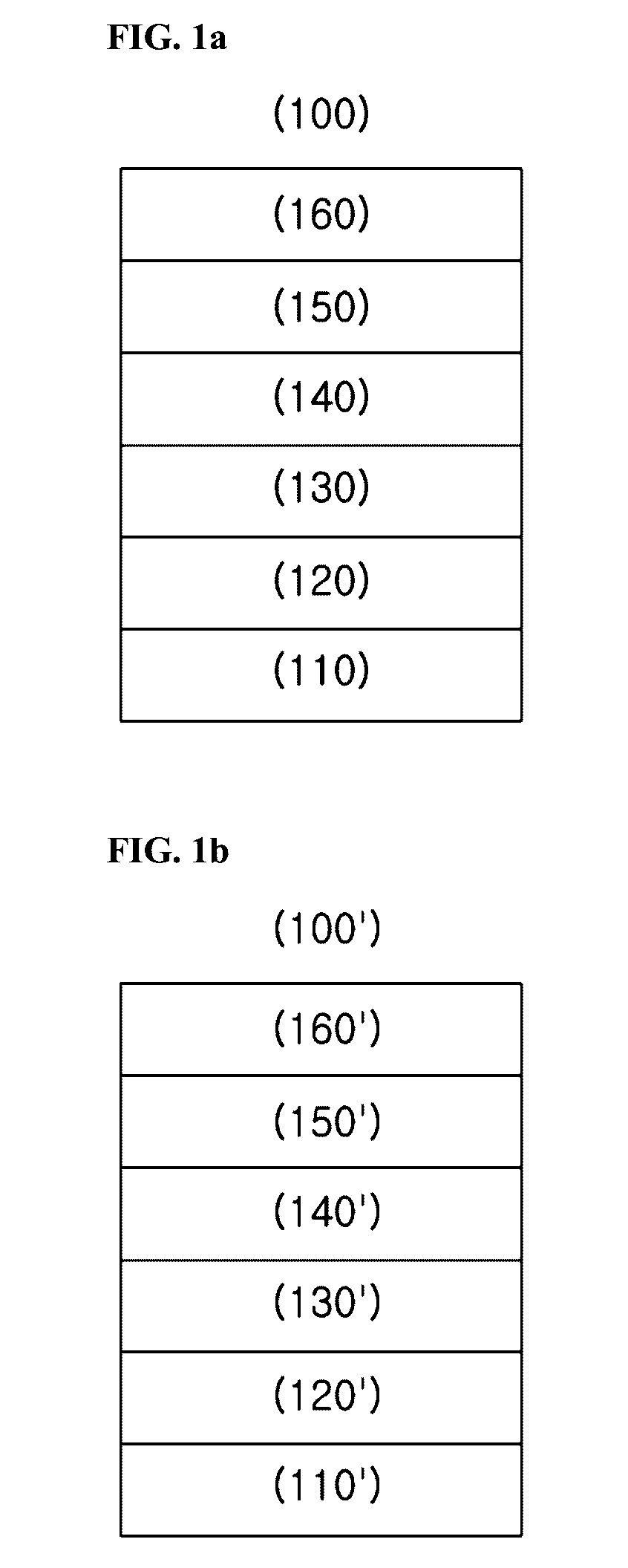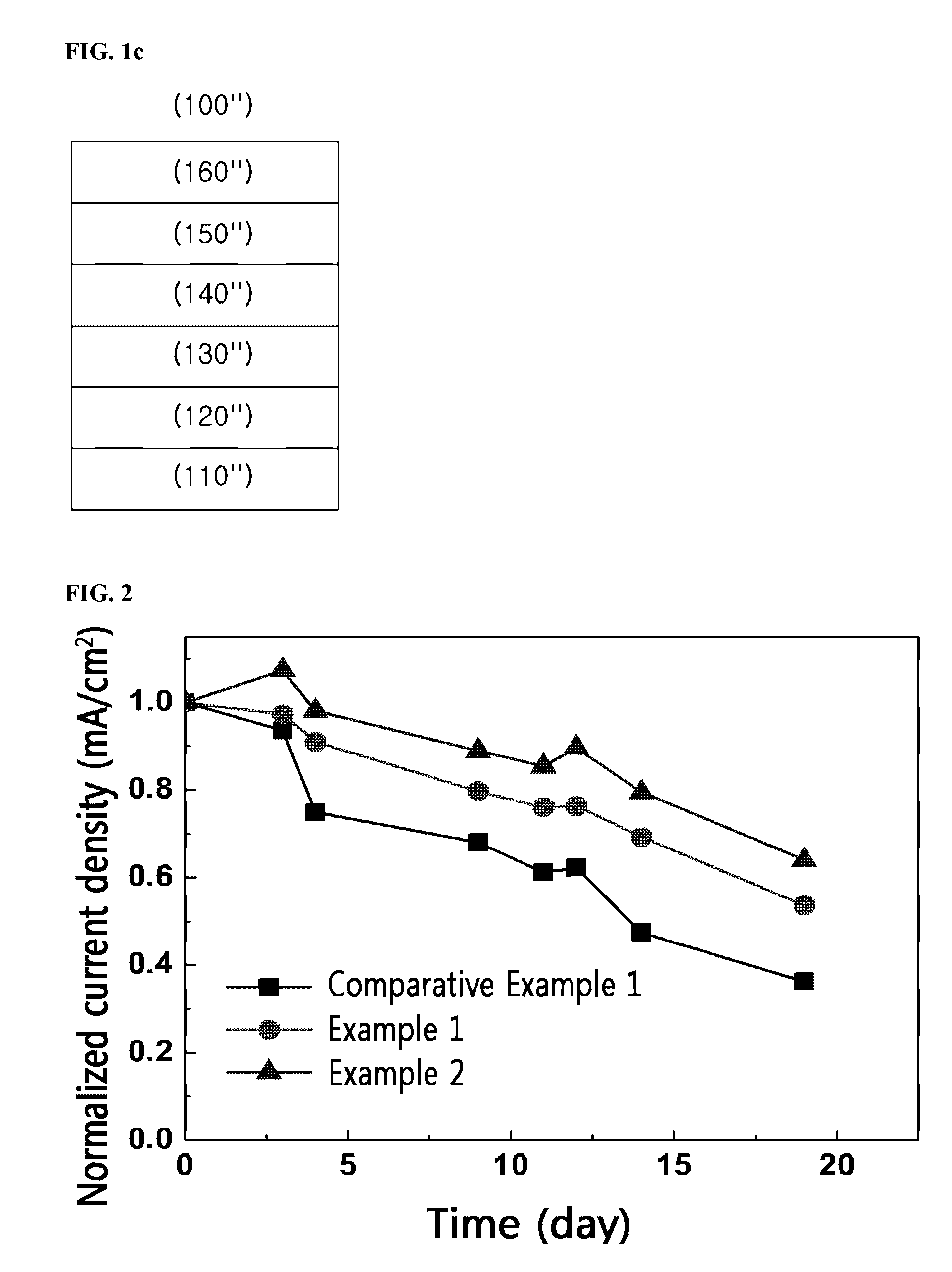Moisture barrier film for organic-inorganic hybrid perovskite photovoltaic cell including ionic polymer, photovoltaic cell including the moisture barrier film and method for fabricating the photovoltaic cell
a technology of organic-inorganic hybrid perovskite and moisture barrier film, which is applied in the direction of photovoltaic energy generation, electrical equipment, and solar cells, can solve the problems of high fabrication cost, low conversion efficiency, and high cost of solar cells, and achieve the effects of enhancing physical and chemical binding therebetween, maintaining excellent characteristics, and maintaining excellent characteristics
- Summary
- Abstract
- Description
- Claims
- Application Information
AI Technical Summary
Benefits of technology
Problems solved by technology
Method used
Image
Examples
example 4
PREPARATIVE EXAMPLE 4
Preparation of 1,1,4,7,10,10-Hexamethyltriethylenetetramine Solutions
[0138]1,1,4,7,10,10-hexamethyltriethylenetetramine was dissolved in chlorobenzene by sonication for 10 min to prepare a mixture solution having a concentration of 1-3 mg / ml. The mixture solution was diluted with chlorobenzene to prepare 1,1,4,7,10,10-hexamethyltriethyl enetetramine solutions having concentrations of 0.1 mg / ml and 0.08 mg / ml.
[0139]The 1,1,4,7,10,10-hexamethyltriethylenetetramine is represented by Formula 17:
[0140]wherein N is from 100 to 1,000.
[0141]The number average molecular weight of the 1,1,4,7,10,10-hexamethyltriethylenetetramine in the 1,1,4,7,10,10-hexamethyltriethylenetetramine solutions was 29,000.
example 5
PREPARATIVE EXAMPLE 5
Preparation of tris(2-aminoethyl)amine Solutions
[0142]Tris(2-aminoethyl)amine was dissolved in 2-propanol by sonication for 10 min to prepare a mixture solution having a concentration of 1-3 mg / ml. The mixture solution was diluted with 2-propanol to prepare tris(2-aminoethyl)amine solutions having concentrations of 0.1 mg / ml and 0.08 mg / ml.
[0143]The tris(2-aminoethyl)amine is represented by Formula 3:
[0144]wherein N is from 100 to 1,000.
[0145]The number average molecular weight of the tris(2-aminoethyl)amine in the tris(2-aminoethyl)amine solutions was 24,000.
example 6
PREPARATIVE EXAMPLE 6
Preparation of tris(2-(isopropylamino)ethyl)amine Solutions
[0146]Tris(2-(isopropylamino)ethyl)amine was dissolved in o-xylene by sonication for 20 min to prepare a mixture solution having a concentration of 1-3 mg / ml. The mixture solution was diluted with o-xylene to prepare tris(2-(isopropylamino)ethyl)amine solutions having concentrations of 0.1 mg / ml and 0.08 mg / ml.
[0147]The tris(2-(isopropylamino)ethyl)amine is represented by Formula 18:
[0148]wherein N is from 100 to 1,000.
[0149]The number average molecular weight of the tris(2-(isopropylamino)ethyl)amine in the tris(2-(isopropylamino)ethyl)amine solutions was 26,000.
PUM
 Login to View More
Login to View More Abstract
Description
Claims
Application Information
 Login to View More
Login to View More - R&D
- Intellectual Property
- Life Sciences
- Materials
- Tech Scout
- Unparalleled Data Quality
- Higher Quality Content
- 60% Fewer Hallucinations
Browse by: Latest US Patents, China's latest patents, Technical Efficacy Thesaurus, Application Domain, Technology Topic, Popular Technical Reports.
© 2025 PatSnap. All rights reserved.Legal|Privacy policy|Modern Slavery Act Transparency Statement|Sitemap|About US| Contact US: help@patsnap.com



